2010 Hyundai H-100 Truck engine
[x] Cancel search: enginePage 1 of 207
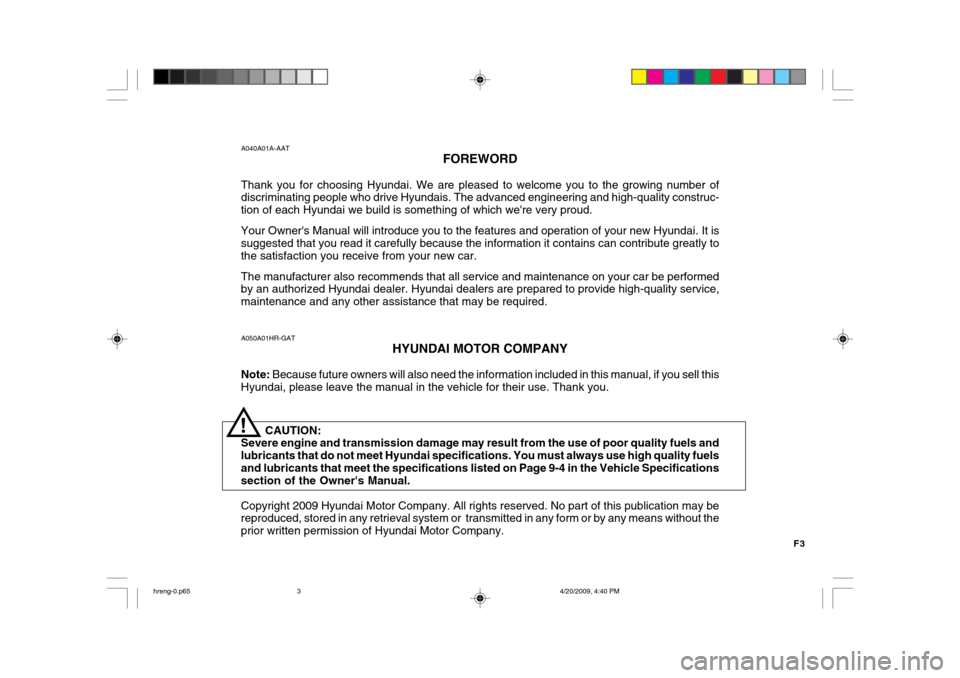
F3
A050A01HR-GAT
HYUNDAI MOTOR COMPANY
Note: Because future owners will also need the information included in this manual, if you sell this
Hyundai, please leave the manual in the vehicle for their use. Thank you.
CAUTION:
Severe engine and transmission damage may result from the use of poor quality fuels and lubricants that do not meet Hyundai specifications. You must always use high quality fuelsand lubricants that meet the specifications listed on Page 9-4 in the Vehicle Specifications section of the Owner's Manual. Copyright 2009 Hyundai Motor Company. All rights reserved. No part of this publication may be reproduced, stored in any retrieval system or transmitted in any form or by any means without the prior written permission of Hyundai Motor Company.
A040A01A-AAT
FOREWORD
Thank you for choosing Hyundai. We are pleased to welcome you to the growing number of discriminating people who drive Hyundais. The advanced engineering and high-quality construc- tion of each Hyundai we build is something of which we're very proud. Your Owner's Manual will introduce you to the features and operation of your new Hyundai. It is suggested that you read it carefully because the information it contains can contribute greatly to the satisfaction you receive from your new car. The manufacturer also recommends that all service and maintenance on your car be performed by an authorized Hyundai dealer. Hyundai dealers are prepared to provide high-quality service, maintenance and any other assistance that may be required.
!
hreng-0.p65 4/20/2009, 4:40 PM
3
Page 2 of 207
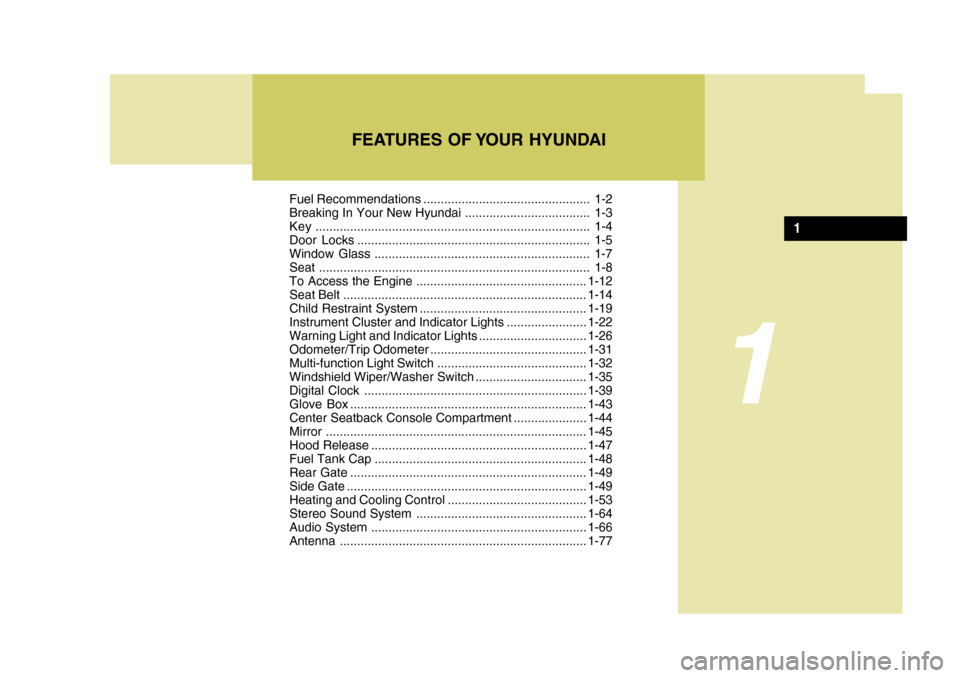
Fuel Recommendations ................................................ 1-2
Breaking In Your New Hyundai .................................... 1-3
Key ............................................................................... 1-4
Door Locks ................................................................... 1-5
Window Glass .............................................................. 1-7
Seat ..............................................................................1-8
To Access the Engine ................................................. 1-12
Seat Belt ...................................................................... 1-14
Child Restraint System ................................................ 1-19
Instrument Cluster and Indicator Lights .......................1-22
Warning Light and Indicator Lights ...............................1-26
Odometer/Trip O dometer............................................. 1-31
Multi-function Light Switch ........................................... 1-32
Windshield Wiper/Washer Switch ................................1-35
Digital Clock ................................................................ 1-39
Glove Box .................................................................... 1-43
Center Seatback Console Compart ment .....................1-44
Mirror ........................................................................... 1-45
Hood R elease .............................................................. 1-47
Fuel Tank Ca p ............................................................. 1-48
Rear Gat e .................................................................... 1-49
Side Gate ..................................................................... 1-49
Heating and Cooling Control .......... ..............................1-53
Stereo Sound System ................................................. 1-64
Audio System .............................................................. 1-66
Antenna ....................................................................... 1-77
FEATURES OF YOUR HYUNDAI
1
1
Page 3 of 207
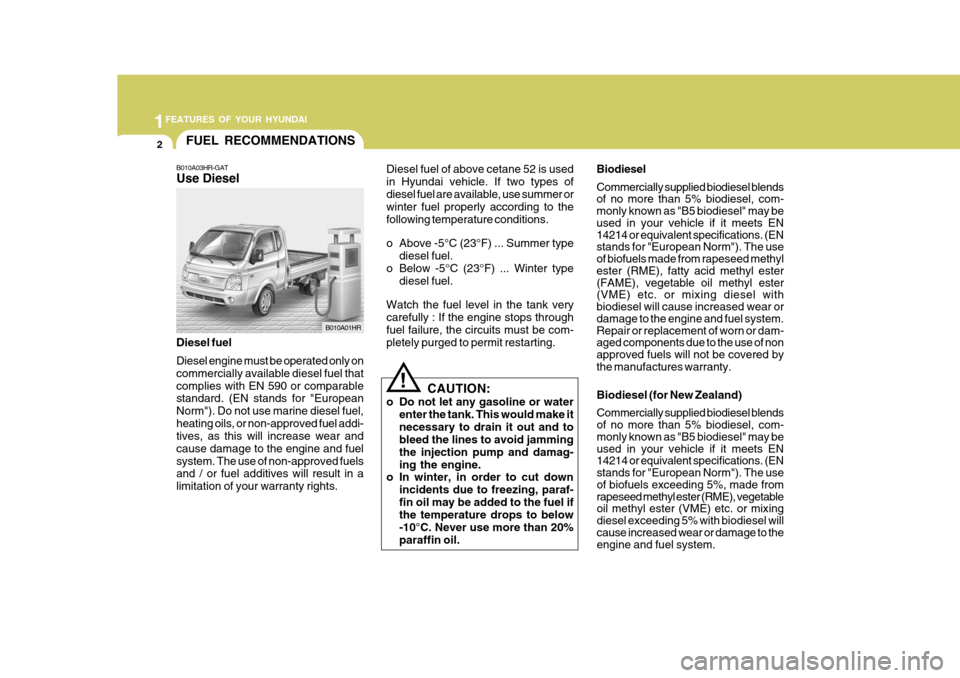
1FEATURES OF YOUR HYUNDAI
2
!
FUEL RECOMMENDATIONS
B010A03HR-GAT Use Diesel
CAUTION:
o Do not let any gasoline or water enter the tank. This would make it necessary to drain it out and to bleed the lines to avoid jamming the injection pump and damag-ing the engine.
o In winter, in order to cut down
incidents due to freezing, paraf-fin oil may be added to the fuel if the temperature drops to below -10°C. Never use more than 20%paraffin oil.
Diesel fuel Diesel engine must be operated only on commercially available diesel fuel thatcomplies with EN 590 or comparable standard. (EN stands for "European Norm"). Do not use marine diesel fuel,heating oils, or non-approved fuel addi- tives, as this will increase wear and cause damage to the engine and fuelsystem. The use of non-approved fuels and / or fuel additives will result in a limitation of your warranty rights.
B010A01HR
Diesel fuel of above cetane 52 is usedin Hyundai vehicle. If two types ofdiesel fuel are available, use summer or winter fuel properly according to the following temperature conditions.
o Above -5°C (23°F) ... Summer type
diesel fuel.
o Below -5°C (23°F) ... Winter type
diesel fuel.
Watch the fuel level in the tank very carefully : If the engine stops through fuel failure, the circuits must be com- pletely purged to permit restarting. Biodiesel Commercially supplied biodiesel blends of no more than 5% biodiesel, com- monly known as "B5 biodiesel" may be used in your vehicle if it meets EN 14214 or equivalent specifications. (EN stands for "European Norm"). The use of biofuels made from rapeseed methyl ester (RME), fatty acid methyl ester (FAME), vegetable oil methyl ester (VME) etc. or mixing diesel with biodiesel will cause increased wear or damage to the engine and fuel system. Repair or replacement of worn or dam- aged components due to the use of non approved fuels will not be covered by the manufactures warranty.
Biodiesel (for New Zealand) Commercially supplied biodiesel blends of no more than 5% biodiesel, com- monly known as "B5 biodiesel" may be used in your vehicle if it meets EN 14214 or equivalent specifications. (EN stands for "European Norm"). The use of biofuels exceeding 5%, made from rapeseed methyl ester (RME), vegetable oil methyl ester (VME) etc. or mixing diesel exceeding 5% with biodiesel will cause increased wear or damage to the engine and fuel system.
Page 4 of 207
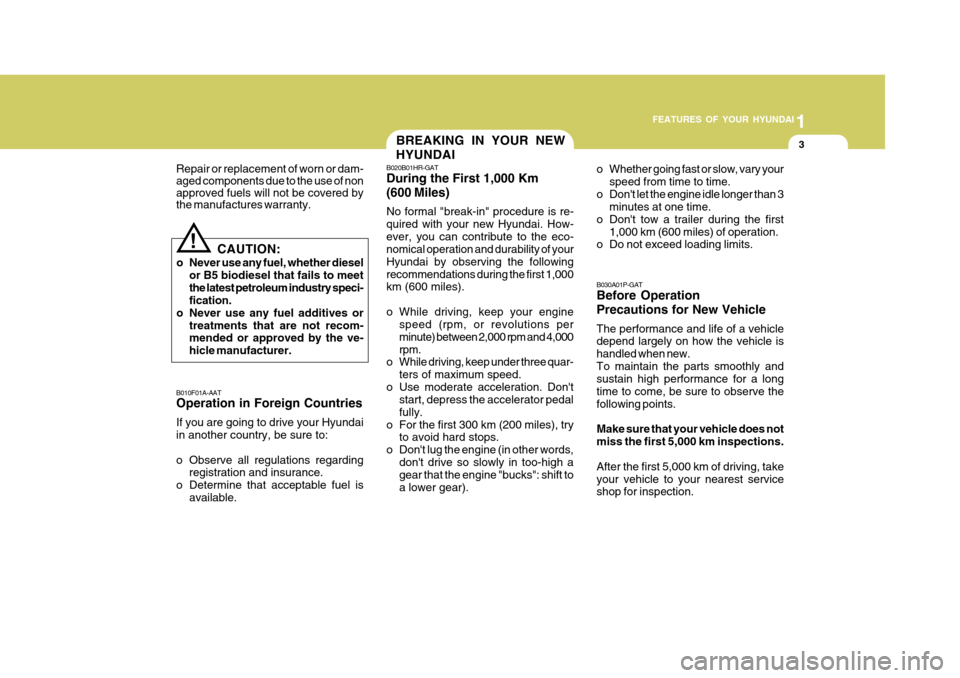
1
FEATURES OF YOUR HYUNDAI
3BREAKING IN YOUR NEW HYUNDAI
B010F01A-AAT Operation in Foreign Countries If you are going to drive your Hyundai in another country, be sure to:
o Observe all regulations regarding registration and insurance.
o Determine that acceptable fuel is available. B020B01HR-GAT During the First 1,000 Km (600 Miles) No formal "break-in" procedure is re- quired with your new Hyundai. How-ever, you can contribute to the eco- nomical operation and durability of your Hyundai by observing the followingrecommendations during the first 1,000 km (600 miles).
o While driving, keep your engine
speed (rpm, or revolutions per minute) between 2,000 rpm and 4,000rpm.
o While driving, keep under three quar-
ters of maximum speed.
o Use moderate acceleration. Don't start, depress the accelerator pedalfully.
o For the first 300 km (200 miles), try to avoid hard stops.
o Don't lug the engine (in other words, don't drive so slowly in too-high a gear that the engine "bucks": shift to a lower gear).
CAUTION:
o Never use any fuel, whether diesel or B5 biodiesel that fails to meetthe latest petroleum industry speci- fication.
o Never use any fuel additives or
treatments that are not recom-mended or approved by the ve- hicle manufacturer.
! o Whether going fast or slow, vary your
speed from time to time.
o Don't let the engine idle longer than 3 minutes at one time.
o Don't tow a trailer during the first
1,000 km (600 miles) of operation.
o Do not exceed loading limits. B030A01P-GAT Before Operation Precautions for New Vehicle The performance and life of a vehicle depend largely on how the vehicle is handled when new.To maintain the parts smoothly and sustain high performance for a long time to come, be sure to observe thefollowing points. Make sure that your vehicle does not miss the first 5,000 km inspections. After the first 5,000 km of driving, take your vehicle to your nearest service shop for inspection.
Repair or replacement of worn or dam- aged components due to the use of non approved fuels will not be covered by the manufactures warranty.
Page 13 of 207
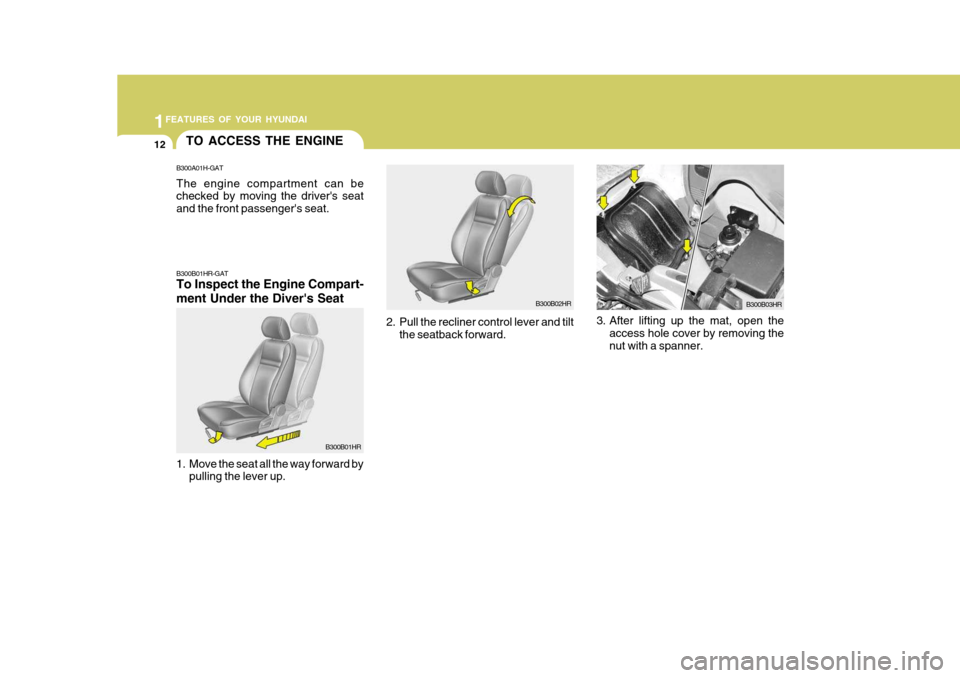
1FEATURES OF YOUR HYUNDAI
12
B300B02HR
2. Pull the recliner control lever and tilt the seatback forward. 3. After lifting up the mat, open the
access hole cover by removing the nut with a spanner. B300B03HR
TO ACCESS THE ENGINE
B300B01HR-GAT To Inspect the Engine Compart- ment Under the Diver's Seat
1. Move the seat all the way forward by
pulling the lever up. B300B01HR
B300A01H-GAT The engine compartment can be checked by moving the driver's seat and the front passenger's seat.
Page 14 of 207
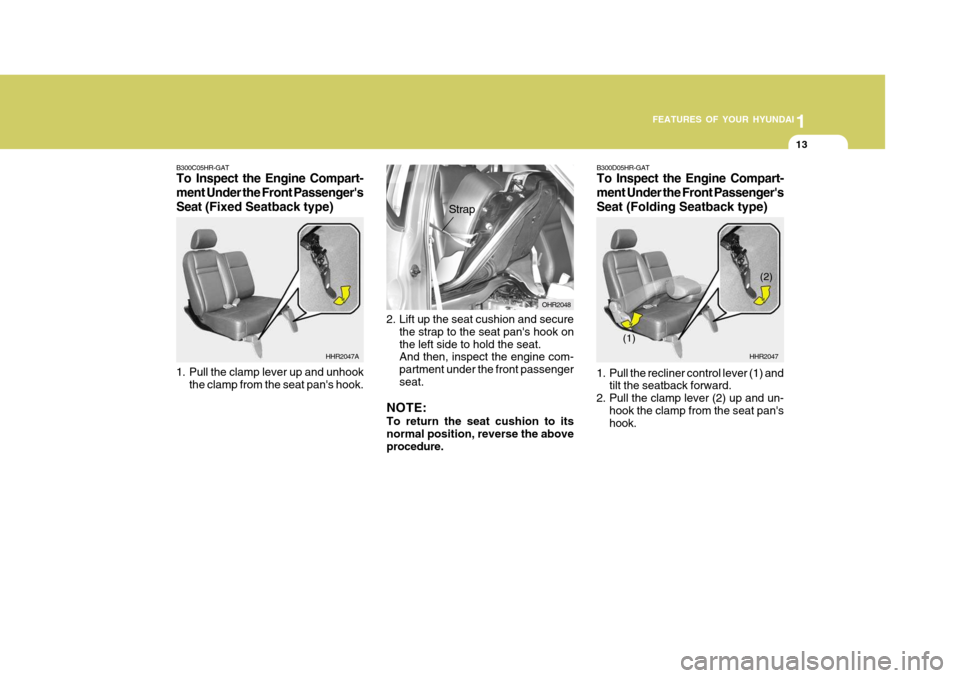
1
FEATURES OF YOUR HYUNDAI
13
1. Pull the clamp lever up and unhook
the clamp from the seat pan's hook. HHR2047A
B300C05HR-GAT
To Inspect the Engine Compart- ment Under the Front Passenger's
Seat (Fixed Seatback type)
2. Lift up the seat cushion and secure
the strap to the seat pan's hook on the left side to hold the seat. And then, inspect the engine com- partment under the front passengerseat.
NOTE: To return the seat cushion to its normal position, reverse the aboveprocedure. OHR2048
Strap
B300D05HR-GAT
To Inspect the Engine Compart- ment Under the Front Passenger's
Seat (Folding Seatback type)
HHR2047
(1) (2)
1. Pull the recliner control lever (1) and tilt the seatback forward.
2. Pull the clamp lever (2) up and un- hook the clamp from the seat pan's hook.
Page 15 of 207
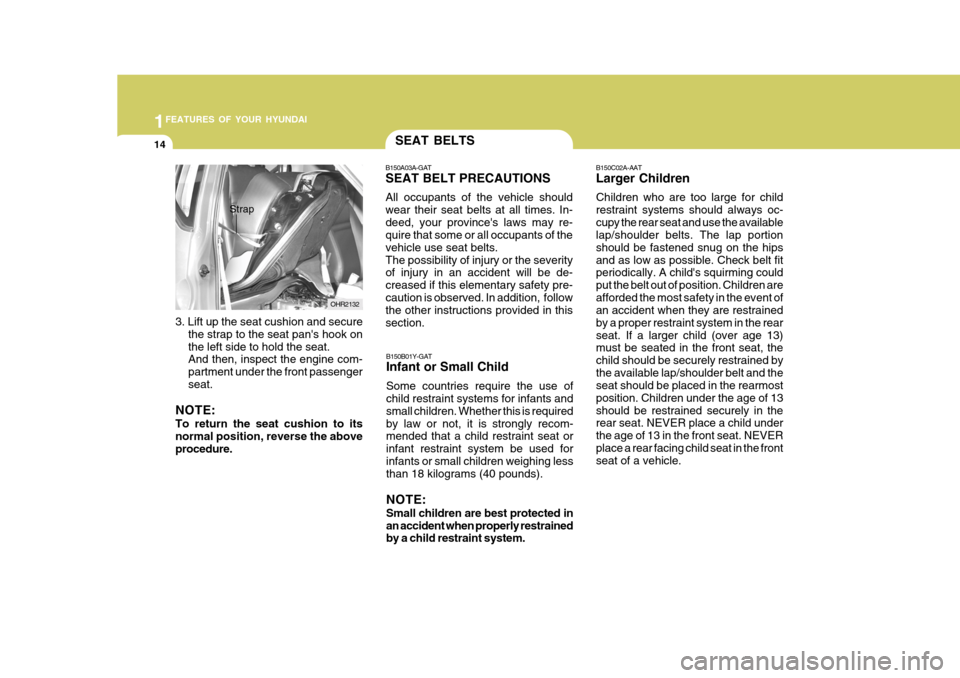
1FEATURES OF YOUR HYUNDAI
14
B150C02A-AAT Larger Children Children who are too large for child restraint systems should always oc-cupy the rear seat and use the available lap/shoulder belts. The lap portion should be fastened snug on the hipsand as low as possible. Check belt fit periodically. A child's squirming could put the belt out of position. Children areafforded the most safety in the event of an accident when they are restrained by a proper restraint system in the rearseat. If a larger child (over age 13) must be seated in the front seat, the child should be securely restrained bythe available lap/shoulder belt and the seat should be placed in the rearmost position. Children under the age of 13should be restrained securely in the rear seat. NEVER place a child under the age of 13 in the front seat. NEVERplace a rear facing child seat in the front seat of a vehicle.SEAT BELTS
B150A03A-GAT SEAT BELT PRECAUTIONS All occupants of the vehicle should wear their seat belts at all times. In-deed, your province's laws may re- quire that some or all occupants of the vehicle use seat belts.The possibility of injury or the severity of injury in an accident will be de- creased if this elementary safety pre-caution is observed. In addition, follow the other instructions provided in this section.
B150B01Y-GAT Infant or Small Child Some countries require the use of child restraint systems for infants and small children. Whether this is requiredby law or not, it is strongly recom- mended that a child restraint seat or infant restraint system be used forinfants or small children weighing less than 18 kilograms (40 pounds). NOTE: Small children are best protected in an accident when properly restrained by a child restraint system.
OHR2132
3. Lift up the seat cushion and secure the strap to the seat pan's hook on the left side to hold the seat. And then, inspect the engine com- partment under the front passengerseat.
NOTE: To return the seat cushion to its normal position, reverse the aboveprocedure.
Strap
Page 27 of 207
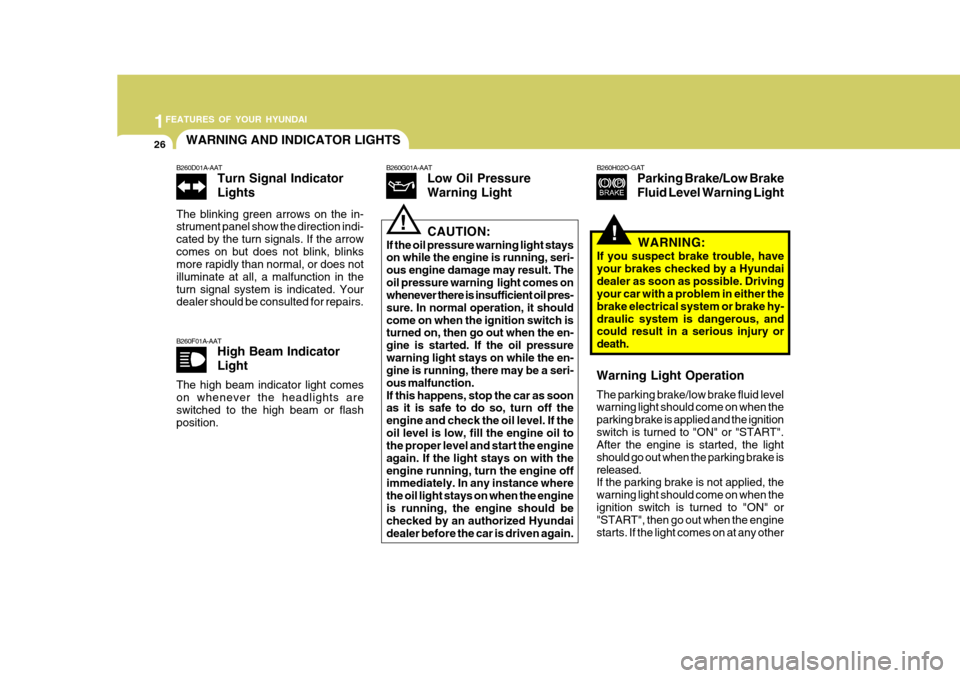
1FEATURES OF YOUR HYUNDAI
26WARNING AND INDICATOR LIGHTS
!
B260F01A-AAT
High Beam Indicator Light
The high beam indicator light comes on whenever the headlights are switched to the high beam or flash position. B260H02O-GAT
Parking Brake/Low Brake Fluid Level Warning Light
B260G01A-AAT
Low Oil PressureWarning Light
!CAUTION:
If the oil pressure warning light stays on while the engine is running, seri- ous engine damage may result. Theoil pressure warning light comes on whenever there is insufficient oil pres- sure. In normal operation, it shouldcome on when the ignition switch is turned on, then go out when the en- gine is started. If the oil pressurewarning light stays on while the en- gine is running, there may be a seri- ous malfunction.If this happens, stop the car as soon as it is safe to do so, turn off the
engine and check the oil level. If the oil level is low, fill the engine oil to the proper level and start the engine again. If the light stays on with theengine running, turn the engine off immediately. In any instance where the oil light stays on when the engineis running, the engine should be checked by an authorized Hyundai dealer before the car is driven again. WARNING:
If you suspect brake trouble, haveyour brakes checked by a Hyundaidealer as soon as possible. Driving your car with a problem in either the brake electrical system or brake hy-draulic system is dangerous, and could result in a serious injury or death.
B260D01A-AAT
Turn Signal Indicator Lights
The blinking green arrows on the in- strument panel show the direction indi- cated by the turn signals. If the arrowcomes on but does not blink, blinks more rapidly than normal, or does not illuminate at all, a malfunction in theturn signal system is indicated. Your dealer should be consulted for repairs.
Warning Light Operation The parking brake/low brake fluid level warning light should come on when the parking brake is applied and the ignitionswitch is turned to "ON" or "START". After the engine is started, the light should go out when the parking brake isreleased. If the parking brake is not applied, the warning light should come on when theignition switch is turned to "ON" or "START", then go out when the engine starts. If the light comes on at any other